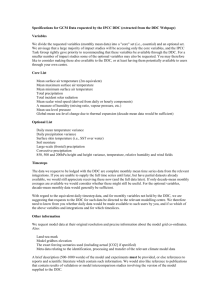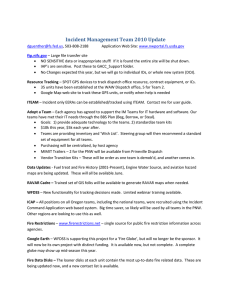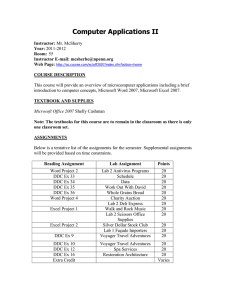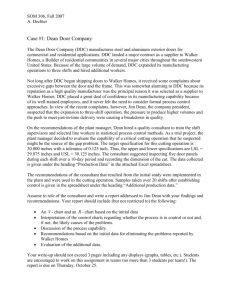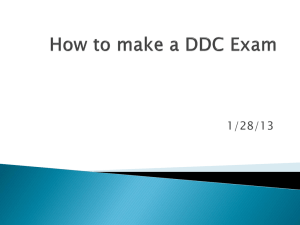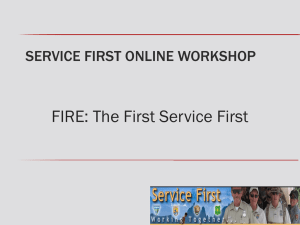21. Dillon Dispatch Dispatching Procedures 21.1 DDC Administrative Procedures
advertisement
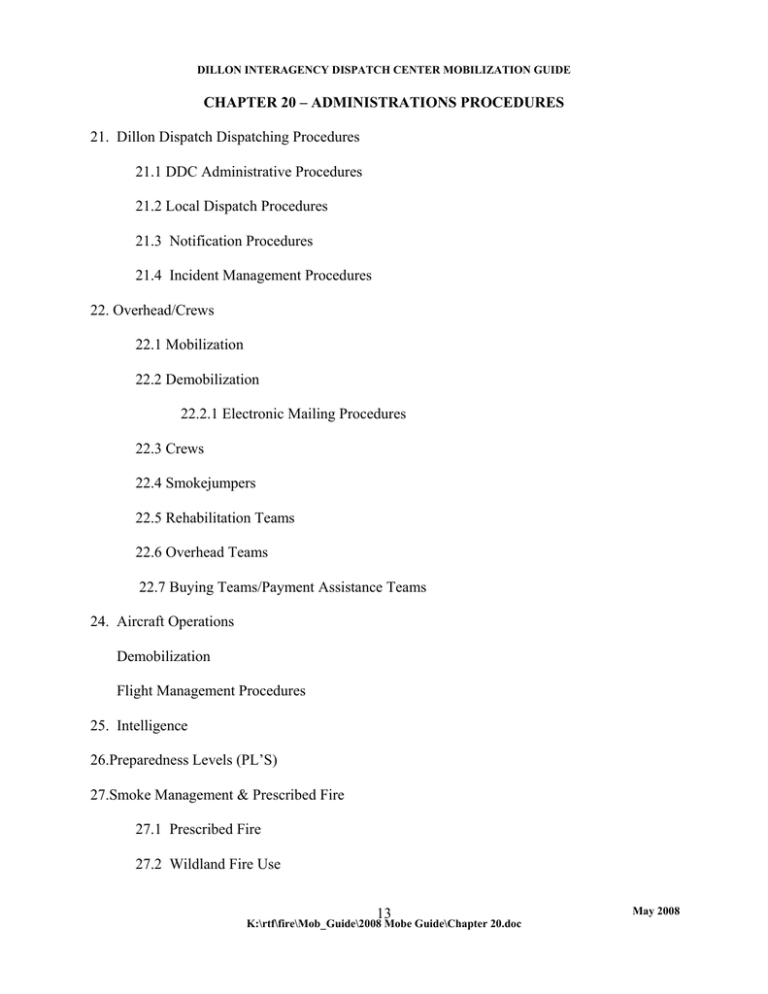
DILLON INTERAGENCY DISPATCH CENTER MOBILIZATION GUIDE CHAPTER 20 – ADMINISTRATIONS PROCEDURES 21. Dillon Dispatch Dispatching Procedures 21.1 DDC Administrative Procedures 21.2 Local Dispatch Procedures 21.3 Notification Procedures 21.4 Incident Management Procedures 22. Overhead/Crews 22.1 Mobilization 22.2 Demobilization 22.2.1 Electronic Mailing Procedures 22.3 Crews 22.4 Smokejumpers 22.5 Rehabilitation Teams 22.6 Overhead Teams 22.7 Buying Teams/Payment Assistance Teams 24. Aircraft Operations Demobilization Flight Management Procedures 25. Intelligence 26.Preparedness Levels (PL’S) 27.Smoke Management & Prescribed Fire 27.1 Prescribed Fire 27.2 Wildland Fire Use 13 K:\rtf\fire\Mob_Guide\2008 Mobe Guide\Chapter 20.doc May 2008 DILLON INTERAGENCY DISPATCH CENTER MOBILIZATION GUIDE 21 Dillon Dispatch Dispatching Procedures 21.1 DDC Administrative Procedures The specific function of the DDC organization is to: 1. Process and fill resource orders for all requests from within and outside of the DDC operational area. 2. Maintain and monitor the various Incident Qualifications Data Bases for the Beaverhead-Deerlodge National Forests, Butte and Dillon Field Offices of the BLM. 3. Coordinate wildland fire training for the DDC zone. 4. Process and fill orders for incidents when DDC is the ordering point for aircraft. (See Chapter 80) 5. Flight follow all aircraft used with in the DDC zone that are under the administrative jurisdiction of DDC. Aircraft Search and Rescue Guides for both Federal & State aircraft will be located near the radio console in DDC (See Chapter 80) 6. Collect and distribute weather information, forecasts and NFDRS indices for the DDC zone. 7. Monitor the prescribed burning programs, including brush disposal and coordinate the smoke management program for the DDC zone. Act as the airshed coordinator for Airshed 5 and 7. Provide support to burn projects as requested. 8. Provide communications for other units and districts as requested. 9. Coordinate and/or assist zone emergencies, search and rescue operations, and law enforcement activities associated with such emergencies. 10. Coordinate detection flights. 11. Monitor DDC zone mobilization levels and coordinate resource availability accordingly. Provide situation reports to requesting units. 12. Contact Agency Duty Officer to arrange for Resource Advisors. 13. WILDCAD will be used for all reports of smoke/fires that come to DDC. 14 K:\rtf\fire\Mob_Guide\2008 Mobe Guide\Chapter 20.doc May 2008 DILLON INTERAGENCY DISPATCH CENTER MOBILIZATION GUIDE 14. DDC will read morning and afternoon fire weather and fire weather watches and red flag warnings over the radio. Fire Weather Warnings and Red Flag Warnings will require acknowledgment from units in the field and district duty officers. 15. DDC will ensure that arriving resources have positive documented contact with the Incident Commander, Operations Sections Chief or other appropriate incident management personnel. This must occur prior to any work commencing on the fire. 21.2 Local Dispatch Procedures 1. Dispatch personnel, aircraft, equipment and supplies to initial and extended attack incidents on lands within DDC’s jurisdiction. 2. Process and fill resource orders for all fires within DDC’s jurisdiction. Expand the dispatch organization to handle the increased workload as necessary. 3. Coordinate with local cooperators, i.e. volunteer fire departments, emergency and disaster service, sheriff’s office, etc. 21.3 Notification Procedures 1. For all BLM, class A and B, fires, the appropriate field office will be notified after the fire is staffed and the first on scene report is received by DDC. For fires that are anticipated to be class C or larger, field offices will be notified as soon as possible. DDC will be responsible for notifying the BLM FMO or acting. BLM fire numbers will be assigned by DDC and included in the information forwarded to the BLM. The BLM will decide whether a resource advisor will be dispatched to the fire. In any area with a heavy equipment restriction, BLM Area Manager approvals are required prior to the use of heavy equipment. Heavy equipment is defined as any piece of equipment capable of altering the landscape by physically reshaping the terrain. 2. Suppression responsibility lies with the agency having protection responsibility for that area. Notification will be given to that unit and the closest available resource will be dispatched to the incident. When the incident is between two protection boundaries or potentially threatening other agencies lands, all agencies will be notified. 21.4 Incident Business Management Procedures The Dillon Dispatch Center will utilize the Interagency Incident Business Management Handbook as the principle guide for business practices. The agency specific guidelines and policies for the agency with protection for the incident will also be followed. 15 K:\rtf\fire\Mob_Guide\2008 Mobe Guide\Chapter 20.doc May 2008 DILLON INTERAGENCY DISPATCH CENTER MOBILIZATION GUIDE Procurement Guide 1. The Beaverhead-Deerlodge will utilize a Forest Service and Supply Plan for acquisition of supplies and services related to emergency incidents under the jurisdiction of the Beaverhead-Deerlodge National Forest. The Forest Service Supply plan will be assembled and updated by the S. O. acquisition staff. The plan will include meal and sack lunch agreements, lodging agreements, service agreements for Agency-Provided Medical Care, Emergency Equipment Rental Agreements and local interagency agreements. Dillon Unit DNRC will utilize a state service and supply plan and DNRC agreements. Incident Business Advisor/Comptroller 2. An Incident Business Advisor will normally be ordered for Type I and Type II incidents with federal jurisdiction. The Incident Business Advisor (IBA) will function as a liaison between the Agency Administrator and the Incident Management Team. The IBA will normally make visits to the incident, buying team, expanded dispatch, R&R facilities and staging areas to facilitate communication and successful business practices. A technical specialist may accompany the IBA to assist in specific areas of concern. The IBA will ensure that standard business practices are followed. Montana DNRC utilizes the comptroller positions to facilitate incident business management practices. The comptroller interacts with the team and expanded dispatch to ensure that incident is handled in a cost effective manner. Comptrollers and Incident Business Advisors are normally ordered for Type 1 and 2 incidents however; an agency administrator may request business management oversight at any time. Buying Unit Procedures 3. When a Type I or Type II Incident Management Team is assigned to an incident with federal jurisdiction a buying team may be ordered see section 22.7. Drivers or other personnel may be assigned to assist the buying team. Persons assigned as drivers will not drive more than 10 hours per shift as stated in the Health and Safety Code section 12.31. Shifts for drivers should not exceed 12 working hours and 13 total hours. If several drivers are needed, a transportation manager may be appointed to schedule drivers on staggered shifts and monitor the fatigue factor. Safety of employees is the primary concern. Dillon Dispatch will maintain a small Buying Unit Kit as outlined in the National Interagency Buying Team Guide. 16 K:\rtf\fire\Mob_Guide\2008 Mobe Guide\Chapter 20.doc May 2008 DILLON INTERAGENCY DISPATCH CENTER MOBILIZATION GUIDE Prior to demobilization the Buying Team will brief the agency business management and acquisition staff on the status of pending purchases, durable goods purchased and any property items that were purchased. Property Management 4. The host agency expects the incident management team to place a high priority on property management. The Buying Unit Team Leader and Finance Section Chief will be briefed on agency specific property tracking and management procedures by the agency business management and acquisition staff. Incident Management teams have the responsibility to ensure that all property purchased is properly turned over to the host agency. Durable goods purchased in the absence of NFES cache items should be incorporated into National Cache system when possible. If the items cannot be incorporated into the National Cache system they will be incorporated into the host agency cache system. 22 Overhead/Crews 22.1 Mobilization Mobilization activities will be conducted with a high regard for safety and cost effectiveness. It is required that all personnel carry photo identification cards while on incident assignments. This will assist when transportation is done by commercial airline. 22.2 Demobilization Demobilization activities will be conducted with a high regard for safety and cost effectiveness. 22.2.1 Electronic Information Transfer A telephone call will always be required for confirmation of transmitted orders. ROSS (Resource Ordering and Status System) Electronic transfer of resources will be used for sending and receiving orders, transmission of travel information and documentation on all orders. Electronic Mail Procedures (.Mob) These procedures are for the electronic transfer of travel for emergency releases only. Once the travel information is known, the sending dispatch center will forward an electronic message to the receiving unit’s dispatch center within the 17 K:\rtf\fire\Mob_Guide\2008 Mobe Guide\Chapter 20.doc May 2008 DILLON INTERAGENCY DISPATCH CENTER MOBILIZATION GUIDE Northern Rockies and a copy to the Northern Rockies Coordination Center (mtnrc@dms.nwcg.gov ) and DDC. All Messages for out of area requests will be sent directly to mtnrc@dms.nwcg.gov, with a copy to DDC. Dispatch centers are not to forward messages direct to receiving Geographic Area Coordination Centers. NRCC will forward all messages to receiving GACC’s and the NICC. Demobilization will follow the same procedures. 22.3 Crews Northern Rockies Type I crews must meet the minimum standards in the Interagency Hotshot Crew Operations Guide. Standards and procedures for mobilization of Type II crews by DDC are located in Chapter 60. 22.4 Smokejumpers Smokejumpers can be ordered directly from Missoula, West Yellowstone, Grangeville and other established spike bases as identified using closest available forces concept and initial attack agreements. Normal notification procedures will apply when using national resources. Normal hours for smokejumpers at the AFD are 0900-1800. The Forest can specifically request early or late standby should a need for smokejumper forces be anticipated. A charge code will be required for additional standby times. Core hours for smokejumpers will be 1200-1700. 22.5 Rehabilitation Teams There are burned-area rehabilitation teams available to evaluate the need for emergency rehabilitation necessary on a fire site due to fire suppression activities or the fire itself. Any requests for a team will be through DDC. There are no standing rehab teams in the region at this time. 22.6 Overhead Teams East Zone Overhead teams are made up of a mix of qualified interagency personnel from the agencies having fire suppression responsibilities. The agencies are: Beaverhead-Deerlodge, Custer, Helena, Gallatin, and Lewis and Clark National Forests; Montana BLM; Yellowstone National Park, NPS; Billings Area Offices, BIA; and the central, Southern, Eastern, and Northeastern Land Offices, DNRC. Type I, Type 2 teams, Area Command and Fire Use Management Teams will be ordered through NRCC. Upon arrival teams will be briefed using the standard Northern Rockies briefing package located in the Northern Rockies National Interagency Management Team 2008 Operating Plan. This will include information 18 K:\rtf\fire\Mob_Guide\2008 Mobe Guide\Chapter 20.doc May 2008 DILLON INTERAGENCY DISPATCH CENTER MOBILIZATION GUIDE on the WFSA and WFIP, delegation and standard business practices for the agency with jurisdiction. When incidents transition from one team to another or back to the district, a closeout briefing will be scheduled. 22.7 Buying Team/Payment Assistance Teams Buying Teams will normally be ordered for Type 1, Type 2, and FUMT for incidents with federal jurisdiction. Incidents that are not anticipated to last over 5 to 7 days may not have a buying team, but individuals may be ordered to supplement the local procurement staff. These teams will be responsible for the incident procurement; they will interface with local procurement personnel for briefing and guidance as needed. Buying teams will normally be co-located with expanded dispatch. Payment Assistance Teams will be ordered through normal dispatch channels at the request of the Budget and Finance Officer or the Forest Administrative Officer. Incidents with state jurisdiction may request additional procurement help if needed. 24 Aircraft Operations 24.1 Mobilization All aircraft for Forest Service flights will be scheduled and monitored through DDC. For administrative flights, a completed Flight Request/Justification of Administrative Use of Aircraft (Fore FS-5700-10) and Travel Cost Comparison Worksheet (Form FS-5700-11) will given to DDC before the flight is scheduled. Flight following for flights on the zone will be done by DDC unless districts are requested to do so by the aircraft or DDC. See Chapter 80 for specific flight following direction and flight request information. 24.3 Air Patrol Management Procedures Several situations will trigger Air Patrol/Detection Flights. They will be flown when the Zone Staffing Levels reaches IV in the path of recent lightning storms, or over areas of high visitor use. Flights can also be scheduled at the discretion of the Dispatch Center Manager on duty or at the request of a District FMO. Flight following will be done with DDC except when poor radio reception with DDC requires flight following with local units. Air patrol will inform the districts when arriving and departing their area in case the district has special requests such as old fires or reported new smokes they would like checked. DDC will follow the procedures in the Northern Rockies Mob Guide section 87.4 to mitigate the inherent mid-air danger with neighboring units. 19 K:\rtf\fire\Mob_Guide\2008 Mobe Guide\Chapter 20.doc May 2008 DILLON INTERAGENCY DISPATCH CENTER MOBILIZATION GUIDE DDC will coordinate flights with Anaconda Unit per the Annual Operation Plan with Anaconda Unit. 25 Intelligence DDC will submit a Situation Report of all agencies electronically as requested by the Geographic Area Coordination Center (GACC). 26 Preparedness Levels The following specific action and preparedness directives are based on USFS fire danger levels. DNRC has developed different preparedness levels based on fire danger levels that are pertinent to their area of protection. The objective of the following is to outline actions to be taken to meet the various levels of fire activity and fire danger. The zone FMO, with input from the unit FMO’s will establish a fire danger level for the zone. This zone fire danger level will be based on today’s ERC and the projected rating for tomorrow as computed by WIMS. The breakdown by levels for the each fire weather zone was calculated using the computed class level for five staffing levels, based on the 90th and the 97th percentile ERC (NFDRS Fuel Model G) averages for the years 1988-2007. Zone 110 ERC calculations used NFDRS weather stations Wise River, Phillipsburg, and Galena. Zone 111 ERC calculations used NFDRS Weather Stations Jefferson, Ennis, and Red Rocks. The BLM Zone Fire Management officer and the Forest FMO will jointly review the staffing guide annually to insure a level of staffing and action commensurate with the fire danger or risk. A. Preparedness Level The preparedness level is a five-tier (1-5) fire danger rating system that will be based on Energy Release Component and indicators of fire business. The fire business indicators used to calculate the preparedness level are large/multiple fire activity, Red Flag Warnings or Fire Weather Watches, Haines Index, and a measure of Ignition Risk. A flow chart guides personnel through the process. Several procedures and guidelines are to be followed once the preparedness level has been determined. The break points for the planning level are set using a historical analysis (Fire Family Plus) of fire business and its relationship to 1300 RAWS observations entered into the NIFMID database and processed by WIMS, which calculates the staffing index values (BI, ERC, etc). 20 K:\rtf\fire\Mob_Guide\2008 Mobe Guide\Chapter 20.doc May 2008 DILLON INTERAGENCY DISPATCH CENTER MOBILIZATION GUIDE Worksheet Instructions: 1. Staffing Index Value: Place a checkmark indicating the forecasted staffing index/component range in row one. These indices (forecasted by the Missoula Weather Office) are based on the 1300 RAWS observations which are input to the WIMS processor by DDC personnel. 2. Fire Activity: fire activity can be defined as any fire that requires the commitment of one or more Federal suppression resources within the Fire Danger Rating Area. Place a checkmark in the appropriate box in row two. 3. Red Flag Warning or Fire Weather Watch: Place a checkmark in row three based on the presence of these advisories issued by the National Weather Service. 4. Haines Index: Place a checkmark in row four indicating the forecasted Haines Index Range. 5. Ignition Risk: Place a checkmark in row five to indicate the relative risk of human and/or naturally caused ignitions. Human-caused risk is based upon activities such as holidays or special events occurring within the FDRA. During holiday weekends (July 4th, Labor Day and hunting season) or special events, the ignition risk is “High;” otherwise, it is “Low.” Lightning Activity Level (LAL) would be the basis for relative risk for natural ignitions; a forecasted LAL of 1 is “Low” ignition risk; 2 through 6 is “High”. 21 K:\rtf\fire\Mob_Guide\2008 Mobe Guide\Chapter 20.doc May 2008 DILLON INTERAGENCY DISPATCH CENTER MOBILIZATION GUIDE Preparedness Level Worksheet Dillon Interagency Fire Center Low Moderate High ERC (Zone 110 ) Fuel Model G ERC (Zone 111 ) Fuel Model G 1 9 0-19 0-19 9 9 9 No Ø Yes Ø No Ø Yes Ø No Ø Yes Ø No Ø Yes Ø No Ø Yes Ø No Ø Yes Ø No Ø Yes Ø No Ø Yes Ø No Ø 2-4 Ø 2-4 Ø 5-6 Ø 2-4 Ø 5-6 Ø 2-4 Ø 5-6 Ø 2-4 Ø 5-6 Ø 9 Preparedness Level No Ø Yes Ø Yes Ø 2-4 Ø 5-6 Ø Ö Low High Low High Low High Low High Low High Low High Ø Ø Ø Ø Ø Ø Ø Ø Ø Ø Ø Ø Ignition Risk 5 61 Plus 63 Plus Ö Haines Index 4 54-60 55-62 Ö Red Flag Warning Fire Wx Watch 3 40-53 40-54 Extreme Ö Fire Activity 2 20-39 20-39 Very High Ö I II III IV V see Appendix B for Preparedness Level definition - 22 - May 2007 DILLON INTERAGENCY DISPATCH CENTER MOBILIZATION GUIDE 27. Smoke management 27.1 Prescribed Fire DDC needs to be informed of any prescribed burning being done so that the appropriate cooperating agencies can be informed. Each district, field office or unit will be responsible for entering burn information into the smokemu data base, including the new information required for First Order Fire Effects Model (FOFEM.) For prescribed burning, DDC needs to know the following information: a. Location (legal) b. Burn type c. Acreage Burning planned for the following day MUST be reported a day in advance by 11am Burns planned for Saturday, Sunday and Monday will be posted on Friday morning 11 am. DDC will monitor for burning restrictions, burners should also monitor the web site. The Montana State Airshed Group will maintain a web page and restrictions will be posted at (www.smokemu.org.) by 1600 Monday-Friday. Restrictions for Saturday, Sunday and Monday will be posted on Friday afternoon. DDC will be staffed during prescribed burning. If there is a need for dispatch to be open after normal duty hours, a request should be made as soon as the need is known. The BLM retains administration of its prescribed fire program in accordance with the Cooperative Fire Management Agreement dated May of 2006. In accordance with that agreement Clause 22 any party may provide assistance to another to implement Prescribed Fire activities. BLM will provide a copy of the Burn Plan for any cooperative burns to the District FMO involved in the execution and to DDC. BLM will be responsible for the cost share agreement or contact if the project is reimbursable. A copy of the signed burn plan will be sent to DDC by the district/zone prior to implementation. 27.2 Wildland Fire Use The following areas have an approved Wildland Fire Use Plans: Anaconda Pintler Wilderness, Lee Metcalf Wilderness and the Elkhorn Mountains. These plans, in conjunction with the Forest Fire Management Plan, contain prescriptive criteria and implementation direction of wildland fire use applications. These plans are Interagency in nature and require a high degree of cooperation for successful implementation. - 23 May 2007

